Having failed on previous occasions to see the actual races, Jane Keightley finally experiences all the pride and pageantry of Palio week in Siena…
Photos by Jane Keightley
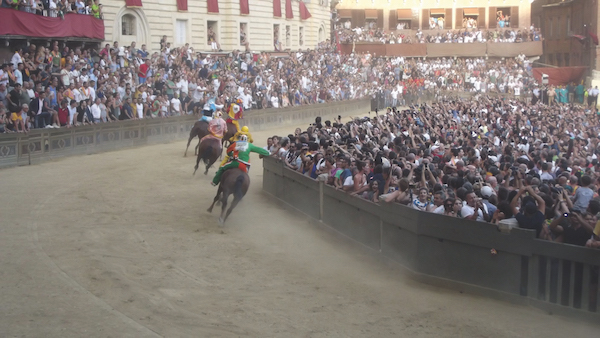
This was far from the first time I had visited Siena, but never before had I actually been there to experience the Palio. On one occasion I had arrived in town the day after, so I had experienced the euphoria of the winning contrada, but not the races themselves. This time, however, I was going to experience the full Quattro giorni del Palio, the four days running up to the event. Hedonistic Hiking, who organises this week, promised total immersion in the Palio experience – and that is precisely what I got.
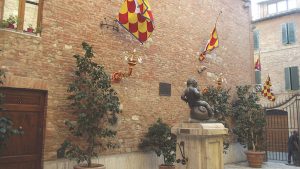 On the first evening we met Alexandra, who showed us round her contrada museum. Almost bursting with pride she explained the history of the Chiocciola (Snail) contrada and showed off the Palio banners they had won in previous races. As I walked around taking in all the history and traditions, I realised that this week was going to be a totally unique experience.
On the first evening we met Alexandra, who showed us round her contrada museum. Almost bursting with pride she explained the history of the Chiocciola (Snail) contrada and showed off the Palio banners they had won in previous races. As I walked around taking in all the history and traditions, I realised that this week was going to be a totally unique experience.
The next chance we got to join in with the build-up to the race was to go down to the Campo to see the horses being allocated to the various contrade. Half the population of Siena seemed to be there and it was hot, noisy and crowded, but as soon as the announcements were made the whole of the Campo was silent.
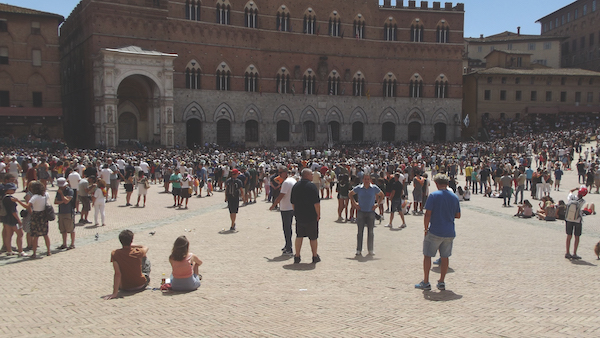
The streets of Siena
In between joining in with all the events I loved to wander around the streets of Siena and feel the rising excitement of the locals, for whom this is one of the highlights of the year. They were all out and about, showing off the colours of their particular contrada by wearing a scarf around their neck or fastened to their bag. Eager tourists wanting to join in with the fun swarmed around the various stalls that sold Palio merchandise, trying to decide which contrada to cheer for so they could buy the right scarf.
Some days we escaped the hustle and bustle of Siena to hike through the Tuscan countryside, and on one occasion we visited an agriturismo, Podere Patrignone, where we learned to make pasta. However, the main focus for me was to make the most of the whole Palio experience and I spent a lot of my time just walking around, exploring the city.
The night before the Palio every contrada has an open-air party and we were lucky enough to attend the dinner of the Valdimontone contrada. Sitting on the streets of Siena on a summer’s evening, being wined and dined amongst a crowd of over 1,500 guests is an experience that will stick in my mind for ever. Add plenty of banging of drums and flag-waving and the singing of contrada songs and you can imagine what a great evening it was. I decided that I was going to cheer for Valdimontone the next day as they had given us such a good time.
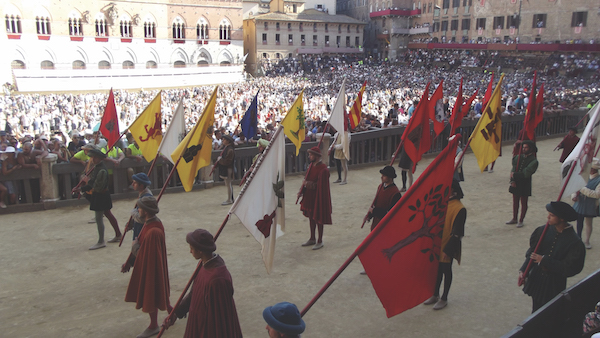
Palio Day
Palio day dawned and the ones amongst us who were not too hungover from the previous night’s celebrations wandered down to the Campo to watch the Bishop of Siena leading Mass in the chapel in the piazza for the jockeys who were riding that day.
As the day went on the tension and excitement mounted, and after lunch we went to watch the outdoor blessing of the Goose contrada. Many contrade bless their horse indoors, in their local chapel, so this gave us the ideal opportunity to join in with the locals – but woe betide any visitor who doesn’t take it seriously and who dares to talk during the ceremony!
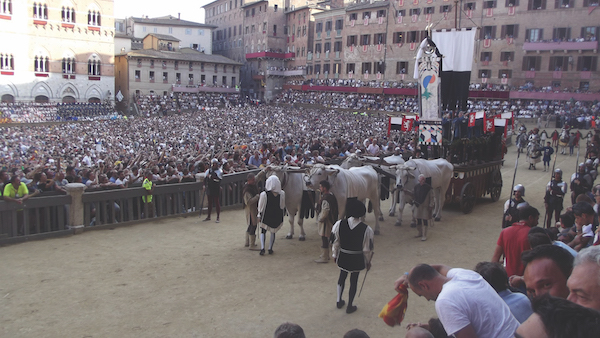
Grandstand seats
Finally, it was time to sit down and watch the race. We were very thankful to have grandstand seats. Many people had camped out in the centre of the Campo all day in the heat to reserve themselves a good position. After nearly four hours of processions, drum-banging and flag-waving, it was finally time for the race to begin.
After a few minutes of the horses jostling about to get their place, they were off. Then as quickly as it started it was finished, in 90 seconds of dust and galloping hooves and the cheers of nearly the whole population of Siena. In front of us the winning jockey was dragged from his horse and carried aloft on people’s shoulders. The cheers were tremendous from the victorious Onda supporters but the other contrade and their supporters didn’t hang about long before they disappeared to lick their wounds and start planning for next year.
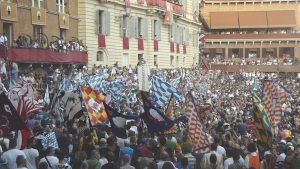 Dining in the Campo that night amongst the celebrations that went well on into the night was so much fun. So many visitors only come for the actual race and do not get the chance to join in with the locals, who are making the most of one of their most important occasions.
Dining in the Campo that night amongst the celebrations that went well on into the night was so much fun. So many visitors only come for the actual race and do not get the chance to join in with the locals, who are making the most of one of their most important occasions.
This being a trip hosted by Hedonistic Hiking, on our last day in Siena, we went for a gentle hike along the banks of the River Merse in the Tuscan countryside. It was a great way to relax after the excitement and tensions of the previous day. While enjoying the walk, I reflected on how the week had brought the history, the culture and spirit of Siena alive to me. It is a week I will never forget.
A guide to the contrade of Siena:
Aquila Eagle Nicchio Shell
Bruco Caterpillar Oca Goose
Chiocciola Snail Onda Wave
Civetta Owl Pantera Panther
Drago Dragon Selva Forest
Giraffa Giraffe Tartuca Tortoise
Istrice Porcupine Torre Tower
Leocorno Unicorn Valdimontone Valley of the Ram
Lupa She-wolf
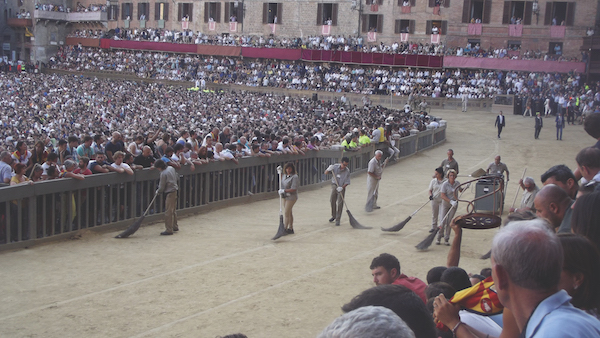
History of the Palio
The Palio is a bareback race and bitterly contested competition between the various contrade, or districts, of Siena in Tuscany. It is held in the Campo, the beautiful shell-shaped piazza in the centre of Siena. Horses and jockeys run three laps around the ring of soil placed on the outer perimeter of the Campo. The origins of this unique spectacle go back to the 13th century when a horse race and a feast were held to give thanks to the Madonna for Siena’s victory at the Battle of Montaperti in 1260. The first Palio on record was in 1310 but the race has changed a great deal over the centuries.
It is often assumed that there have always been only the 17 contrade that take part in the Palio now. However, back in the early 13th century there were 80 of these districts. Following the Black Death in 1348 some of them disappeared while others were incorporated into neighbouring districts until eventually there were just 42. As time went on they were reduced further still until, in 1729, the number was fixed at 17, as it remains to this day. The contrade all have a special name and their own heraldic symbol and colours. In some cases they have traditional allies and enemies.
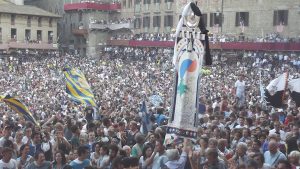
The two Palios
There are actually two Palios. The first is held on the 2nd of July and the second on the 16th of August. Ten out of the 17 contrade take part in each as there is no room for any more than that. Seven are guaranteed a place if they missed the July race the previous year and the other three are drawn by lots.
A week before the race the perimeters of the Campo are covered with earth, “La terra in piazza”, to create the track. Three days before the race there is a public draw to assign horses to each contrada and once allotted they cannot be changed. The horses are then led to special stalls in their contrada and are placed under 24-hour surveillance to prevent doping.
On the day of the race the horse and jockey are blessed in the relevant contrada church. The race is preceded by a grand procession with contrada members dressed in medieval costumes waving flags and beating drums. Once the race is over – it only lasts 90 seconds – the celebrations begin. The silk banner that is the prize is called the palio and is where the name of the race comes from. Since 1970 the banner for the August palio has been designed by leading Italian artists but it always has to bear an image of the Madonna. This much-coveted banner is paraded around the streets with great pride by the winners. Celebrations continue most of the night and after a few weeks a special celebration dinner is held by the winning contrada, with their horse being the guest of honour.
Jane was in Siena as a guest of Hedonistic Hiking
Tel (UK): 01858 565148
Tel (Italy) +39 333 319 4203
info@hedonistichiking.com
Our Siena attractions guide has the six top things to do while visiting the city…
